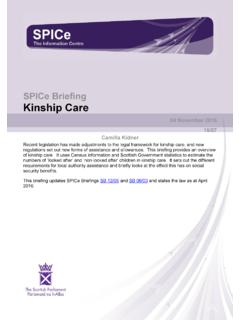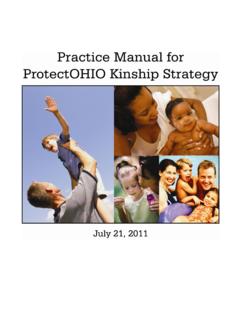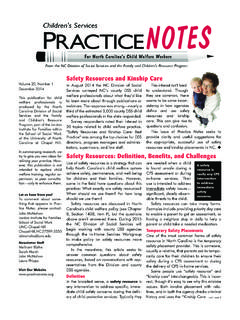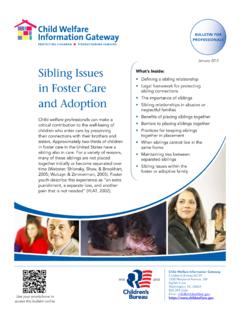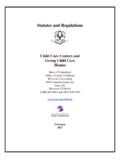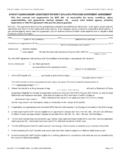Transcription of ENGAGING KINSHIP CAREGIVERS: MANAGING …
1 ENGAGING KINSHIP caregivers : MANAGING RISK factors IN KINSHIP care . Video Training Series Discussion Guide FALL 2017. ENGAGING KINSHIP caregivers | USING THIS GUIDE. This video discussion guide aims to help those who have viewed the training series, ENGAGING KINSHIP caregivers : MANAGING Risk factors in KINSHIP care , and wish to expand their learning through group exercises and discussion, and to practice the strategies they have learned through the series. The guide is designed for use with small groups led by program directors, supervisors and trainers. Individuals can apply the questions and prompts on their own or with a colleague to deepen their understanding of the concepts. The video training series may be found at ACKNOWLEDGMENTS. The Annie E. Casey Foundation thanks Dr. Joseph Crumbley, whose deep expertise and extraordinary teaching wisdom have made this video training series possible.
2 The Foundation also thanks the University of Pennsylvania Perelman Quadrangle, where the training was taped, for video production, and Philadelphia child welfare professionals who made up the live audience for the training session. ABOUT THE ANNIE E. CASEY FOUNDATION. The Annie E. Casey Foundation is a private philanthropy that creates a brighter future for the nation's children by developing solutions to strengthen families, build paths to economic opportunity and transform struggling communities into safe and healthier places to live, work and grow. For more information, visit the Foundation's website at | ENGAGING KINSHIP caregivers . CONTENTS. 2 MODULE 1: GUILT. 4 MODULE 2: LOSS AND AMBIVALENCE. 7 MODULE 3: PROJECTIONS AND TRANSFERENCE. 10 MODULE 4: HOPE, FANTASY AND DENIAL. 12 MODULE 5: LOYALTY ISSUES. Module 1: GUILT.
3 This module explores how to manage the understandable feelings of guilt that relative caregivers may experience as a result of changing family dynamics. EXPERIENTIAL EXERCISE. Expressing genuine empathy for the ways caregivers respond to their situations is key to working effectively with them. Grasping the fundamental differences between KINSHIP caregiver arrangements and those of nonrelative foster parents also is critical. Lead a group discussion asking these questions: When thinking about the KINSHIP triad, who was the caregiver's initial experiences of attachment and bonding with? (The birth parent). How might the caregiver feel when placing the needs of the children over that of the birth parent? What kinds of comments from the birth parent based on that original attachment of the relative caregiver with the birth parent could trigger feelings of guilt?
4 When considering the nonrelative foster care triad, who was the caregiver's initial experiences of attachment and bonding with? (The child). How is that different from the KINSHIP triad? How might it influence your direct practice with KINSHIP caregivers ? STRATEGIES AND SCRIPTS PRACTICE. In pairs, role-play a conversation between a child welfare professional and a relative caregiver. Each person in the pair takes one of the roles. The caregiver makes some of these kinds of statements below. The child welfare professional responds using the strategies and scripts suggested below. Feel free to elaborate and improvise so that it feels more like a real conversation. After practicing for a while (3 to 5. minutes), switch roles. Kin caregiver statements: Is what's happening to my son, daughter or brother, (the birth parent). my fault?
5 I can't blame my daughter for not wanting her child to live with me.. Did my mistakes as a parent cause my child to turn out this way? . 2 | ENGAGING KINSHIP caregivers . STRATEGIES AND SCRIPTS FOR PROFESSIONALS. GOALS SCRIPTED RESPONSES. Accept past behaviors You've admitted making mistakes and you've said you're sorry. (acceptance). Validate growth Look at how you're different now. (growth/resilience). You're now a better parent than you were in the past because of the sacrifice Self-forgiveness and support you are now giving the birth parent and their child.. Embrace new roles and attachments If not you, then who? If not now, then when? . After completing the role-plays, discuss these questions as a group: In the role of the KINSHIP caregiver, how was it helpful to have the professional respond to your feelings of guilt using the strategies and scripts?
6 As the professional, in what ways could you see the KINSHIP caregiver responding differently to guilt brought on by unreconciled past mistakes or not accepting new roles with the child? CASE PRESENTATION AND DISCUSSION. Think about one of your KINSHIP cases where guilt is coming up as an issue. Describe the family's situation, using a genogram to include all the relevant members of the KINSHIP triad. Describe how feelings of guilt are expressed. Discuss these questions: How does the setup of KINSHIP care in child welfare unplanned, by default and in a crisis contribute to feelings of guilt for the caregiver? Based on this situation, what are the goals for the KINSHIP caregiver? (See the goals in the Strategies and Scripts chart in the Role Play section above.). How can you support the KINSHIP caregiver in making progress toward these goals?
7 How could this help in MANAGING risk for the child's safety, permanency and well-being? ENGAGING KINSHIP caregivers | 3. Module 2: LOSS AND AMBIVALENCE. This module explores how KINSHIP care creates interruptions of the caregiver's plans, priorities, space and privacy especially since it is unplanned, by default, and in a crisis and how these can contribute to feelings of loss and ambivalence for the relative caregiver. It is critical to understand how these feelings can present risk factors for the child if they aren't addressed. EXPERIENTIAL EXERCISE. Imagine that a relative asks you to take her children into your home. You have about a week to get ready. How does this change your life? How does this affect you emotionally? Write these down on a flip chart. Now imagine that you just found out that the child welfare agency is involved and you are being asked to care for the children.
8 You learn that abuse and neglect may be the reasons the agency is involved. How does this change your life? How does this affect you emotionally? Add the comments from the group to the flip chart notes. Discussion questions: How did the exercise help you to better understand how the role of relative caregiver is different from nonrelative caregivers ? How do you think these differences can understandably lead to feelings of loss and ambivalence for the KINSHIP caregiver? STRATEGIES AND SCRIPTS PRACTICE. In pairs or on your own, role-play a conversation between a child welfare professional and a relative caregiver. Each person in the pair takes one of the roles. The caregiver makes some of these kinds of statements below. The child welfare professional responds using the strategies and scripts below. Feel free to elaborate and improvise so that it feels more like a real conversation.
9 After practicing for a while (3 to 5. minutes), switch roles. 4 | ENGAGING KINSHIP caregivers . Kin caregiver statements: I am not sure I can do this! . What if things don't work out? Can I change my mind? . I only want to be a grandparent.. STRATEGIES AND SCRIPTS FOR PROFESSIONALS. GOALS SCRIPTED RESPONSES. You should be ambivalent and anticipate sacrifices. This is a decision that's unplanned, in Normalize the loss and ambivalence a crisis with unexpected changes in your life.. Destigmatize the emotions and I can certainly understand why you're hesitant. You might even continue to feel hesitant or hesitations ambivalent even if you decide to take the child into your home.. It's only fair that you have time with the child to determine if it's in your and the child's Elicit caregiver's commitment to best interest to live together.
10 A process to determine if he is a AND/OR. permanency option You have to want the child in order for the child to feel loved and wanted.. We (agency) need for you to tell us what you need in order for you to try taking care of your grandchild.. Identify tasks, benchmarks and timeline AND/OR. for determining permanency plan What accomplishments (indicators) will let you know if you can permanently care for your grandchild? . Develop a process for monitoring, I also need you to let me know when it becomes too much or if you're thinking about identifying and knowing when an changing your mind.. alternative placement plan is necessary Remember, this decision was unplanned, during a crisis that resulted in unexpected changes in your life. It's OK to say, I tried but can't do it.. AND/OR. Make it safe to disclose and talk about We (agency) don't want this to become a crisis situation for you and your grandchild, if alternative involvement you are no longer able to live together.


